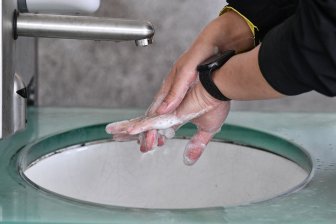You’re at much less risk of catching the novel coronavirus by touching a contaminated surface than by standing close to people, the U.S. Centers for Disease Control and Prevention recently clarified on its website.

The subtle change, on a CDC page, emphasizes that the virus spreads easily between people, through droplets that spread up to around two metres or six feet away, when an infected person coughs, sneezes or talks. These droplets then land in the mouths or noses of others, or are possibly inhaled into the lungs.
“The virus does not spread easily in other ways,” including by touching surfaces, the website says. But that doesn’t mean touch is zero-risk.
“It may be possible that a person can get COVID-19 by touching a surface or object that has the virus on it and then touching their own mouth, nose, or possibly their eyes. This is not thought to be the main way the virus spreads, but we are still learning more about this virus,” the CDC wrote.
While this has been the CDC guidance for some time, the headline emphasizing that the virus does not spread easily this way was added to “clarify” the message, according to a spokesperson.
“COVID-19 spreads mainly through close contact from person-to-person,” the spokesperson wrote.

A Public Health Ontario research summary notes that there is no data showing that the SARS-CoV-2 virus, which causes COVID-19, can survive on a surface and be passed on to others who touch that surface. But, the agency says, they believe that this is a likely source of transmission based on how other viruses spread.

Get weekly health news
A recent letter published in the New England Journal of Medicine found traces of the virus on some surfaces after a few hours, and others, after a few days. Public Health Ontario also notes that some studies have found evidence of the virus on various objects in COVID-19 patients’ rooms.
“We know people have been in close contact with each other, but we’re not entirely sure of how they acquired it,” said Dr. Isaac Bogoch, an infectious disease specialist at Toronto General Hospital.
Specific studies haven’t been done to determine whether someone caught the virus through inhaling droplets that someone coughed or whether they touched a contaminated surface and then touched their mouth, he said.
However, touching higher-contact surfaces that many other people have touched, like a building’s doorknob or a handrail on the subway, does present some risk, he said. But the riskiest thing to do is to spend time indoors with a symptomatic person.
“Indoors, where you can’t maintain physical distancing with the person who is symptomatic, meaning they’re coughing, that would be the highest-risk setting,” Bogoch said.

Even if you’re less likely to catch the virus from touching surfaces, public health authorities, including the CDC and Canadian agencies, recommend frequent handwashing to cut your risk, and using hand sanitizer when water isn’t available.
Bogoch doesn’t think it’s necessary to disinfect your groceries or other objects you bring into your home, though some people may want to.
“At the end of the day, the risk of getting this infection through those means is certainly extremely low. Of course, it’s not zero percent, but it’s really low,” he said.
“And if people are doing that, because this will help them get through their day, I’m all for it. Some people will choose not to do that. Their risk threshold, their risk perception, their risk tolerance may be different. That’s also fine as well.”
Questions about COVID-19? Here are some things you need to know:
Symptoms can include fever, cough and difficulty breathing — very similar to a cold or flu. Some people can develop a more severe illness. People most at risk of this include older adults and people with severe chronic medical conditions like heart, lung or kidney disease. If you develop symptoms, contact public health authorities.
To prevent the virus from spreading, experts recommend frequent handwashing and coughing into your sleeve. They also recommend minimizing contact with others, staying home as much as possible and maintaining a distance of two metres from other people if you go out.
For full COVID-19 coverage from Global News, click here.




Comments